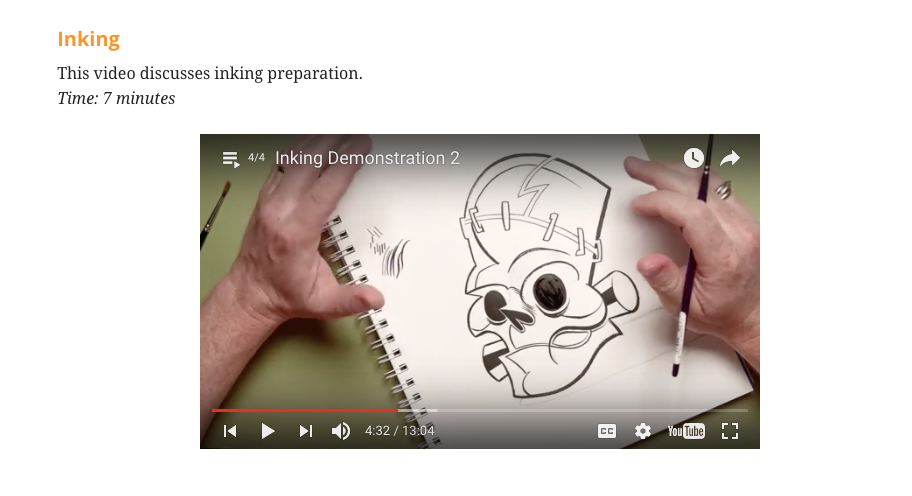
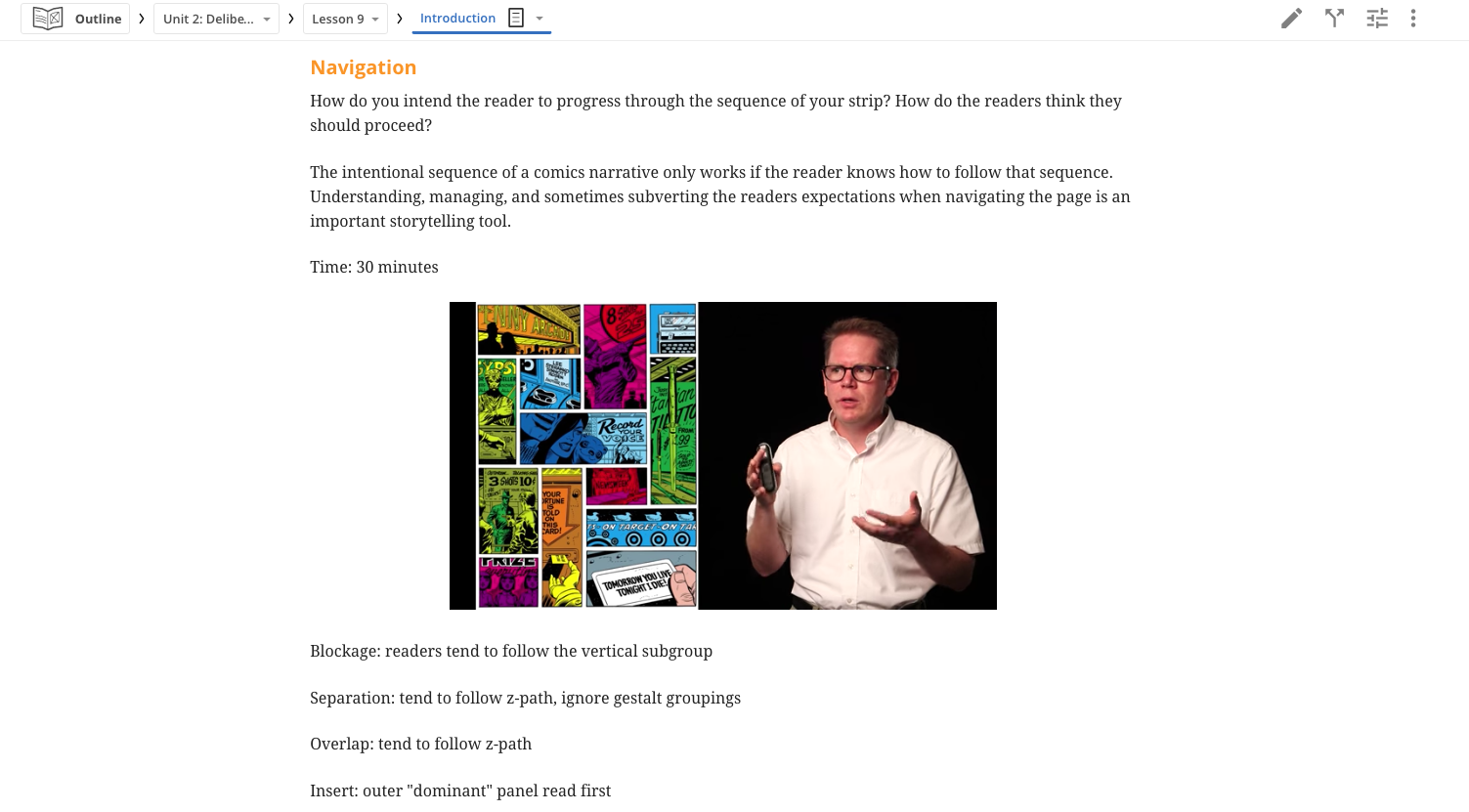
Gary Chinn, Assistant Dean for Digital Learning; Jessica Briskin, doctoral candidate in the Learning, Design, and Technology program; Susan Land, Associate Professor of Education; Joel Priddy, Associate Professor of Graphic Design, Pennsylvania State University
In art and design disciplines, studios are spaces in which drawing, debate and analysis of design take place (Broadfoot and Bennett, 2003). This article explores studio-based instruction and the learning and critiquing processes involved, and how digital tools might play a role in these processes. First, it provides a brief overview of the pedagogical approaches unique to art and design instruction, with a focus on existing literature related to learning and studio practice. Next, the paper discusses the roles of the learner, artefacts and community within studio learning, concluding with an examination of an online studio platform within a course on graphic novels. The blended learning approach of this course (combining in-person and online) provides an opportunity to make comparative observations of student activity, collaboration and its effects on the learner, the community and development of an artefact.
studio; design; digital; virtual; critique; artefact
A studio is a unique pedagogical environment within art and design disciplines. Signature aspects of a studio, such as consistent feedback, peer assessment, and the open nature of working in this environment, create a learning space that facilitates regular communication and iterative approaches. Learning within a studio is often approached from a problem-based perspective, where feedback from both experts and peers (referred to within this discussion as ‘critique’) is essential to the instructional process. Focus on the process of making artefacts ‐ another hallmark of a studio ‐ works in tandem with frequent critique to provide students with meaningful assessments of their work. As technologies for teaching continue to evolve, it becomes increasingly important to examine the intersection of the design studio and digital technology. Specifically, what key aspects comprise studio-based learning, and how might digital tools for teaching alter those aspects? This study explores a creative design studio course in order to approximate two key ‘signature pedagogies’ of the studio, using digital tools to: (1) focus on artefacts and (2) access peer critique. These two aspects are essential to meaningful studio learning and must thus be accounted for when designing digitally mediated ‘virtual’ studio experiences.
The design studio is a highly specific pedagogical environment that often struggles to incorporate new technologies into practice. Key characteristics of the studio as a learning space include regular access to feedback from experts and peers, a continuous refining of work, and public critical feedback via formal ‘critique’ sessions. As previous work in studio pedagogy reveals, there are common characteristics of a meaningful studio experience. These characteristics range from structural (such as the format of information presentation, the physical space) to those more directly related to pedagogy (assignment types, open problems, collaborative and iterative learning and so forth). A meaningful studio experience will effectively incorporate technology into learning. Finally, previous work provides a starting framework for the types of skills and dispositions learners should cultivate in a studio context, for example craft development, engagement, exploration and reflection.
While the design studio as an instructional context is unique, extant research in the learning sciences offers an intriguing lens through which one can examine this environment of learning. There are a number of concepts with the potential to inform and shape the design of virtual studio approaches, for instance those that describe ‘collaborative discourse’ (Nathan and Sawyer, 2014), ‘project-based learning’ (Krajcik and Shin, 2014), ‘constructionism’ (Halverson and Sheridan, 2014), the ‘co- construction of meaning’ (Miyake and Kirscher, 2014), and the use of technology to support collaborative ‘meaning-making’ (Stahl, Koschmann and Suthers, 2014).
While specific definitions of the studio as a context for learning may vary, there is consensus around the key aspects of what Crowther describes as the ‘signature pedagogies’ of the studio (2013). These pedagogies include experimentation, collaboration, the practicing of skills, a focus on artefacts, and dialogue/critique. These characteristics can be broadly categorised as examinations of the individual learner, the constructed object/artefact nature of studio assignments and the social context of the studio community.
For an individual, studio-based approaches can play a role in learning via the self-directed nature of this process and knowledge construction (Galford, Hawkins and Hertweck, 2015). The idea of learning as an activity ‐ learning that is contextualised as opposed to disembodied and separate from practice ‐ clearly manifests within a studio-learning context (Barab et al, 2001).
The production-based nature of studio work opens opportunities for learners to explore arts production as a process of authentic production tasks (Halverson, 2013). Production, in this context, simply refers to engaging in processes that result in a tangible (or made) object. These objects can be analogue or digital in nature, but in either case there is an end product that can be evaluated by peers and instructors. In the context of potential designs of virtual studio environments, a continuation of this line of inquiry can include the role of these objects and artefacts in computer-supported, collaborative learning approaches to co-construction of knowledge (Damsa, 2014).
The community of a studio, comprised of learners and instructors, is a critical aspect of this environment. Interactions that are both formal and informal flow between all members of the studio community, in all directions (Cox, Harrison and Hoadley, 2008). A signature characteristic of the studio is the co-production of knowledge between instructors and students. The dialogues that occur in this context have a significant impact upon collaborative knowledge and how it is built, a critical tool that assists students in developing the skills required to solve ill-structured design problems or resolve community-based issues (Cennamo et al, 2011).
The following analysis provides a deeper exploration of the studio as a pedagogical environment, as well as a discussion of extant literature related to what constitutes ‘studio pedagogy’ and the important roles learners, artefacts and communities play in this context.
Studio pedagogy is viewed as a key aspect of teaching and learning within the art and design disciplines, as indicated by Farias and Wilkie who describe the studio as a ‘center for synthesis’ (2015). But what is studio pedagogy? What specific hallmarks comprise the studio culture? What are students asked to do, with what tools and how? Researchers from various disciplines within the creative art and design fields (visual art, architecture, graphic design, industrial design) have posited key characteristics to assist in illuminating these hallmarks. Studio Thinking 2 (Hetland et al, 2013) offers 4 frameworks that provide a useful starting place for considering the unique characteristics of this context, which involve:
These structures describe broad aspects that are often associated with studio-based learning environments. In this context, the intermixing of lectures with direct demonstration of technique contextualises topics. The idea of ‘students at work’ focuses on the production aspects of studio work. Assignments include tools, materials, and challenges with an end goal of making something. Critique is an essential part of the structure adopted in studio pedagogy, providing opportunities for reflection, feedback and iteration of ideas. Critique supports learner understanding by providing important feedback, permitting them to reflect on and revise their work (Krajcik and Shin, 2014). One important aspect of critique is assisting learners to connect their work process with the final product and accordingly, studio instruction often involves a strong focus on process. Mathews (2010) approaches studio characteristics from an architectural perspective, stating that the ‘core concepts’ of a design studio include open-ended projects, rapid iterations, frequent formal/informal critiques, creative use of constraints and thinking about “the whole”, as opposed to a focus on specific parts.
In discussions of studio pedagogy two aspects appear consistently: (1) the importance of artefacts or products as a vehicle for learning and (2) the essential nature of the studio community to individual learning. It is important to note that this case study involves coordinated efforts to approximate key aspects of studio pedagogy and the research team does not believe that replicating the resident studio experience is a reasonable goal. Instead, we explore what digital versions of specific signature aspects of a studio might look like and how they might be continually refined.
The context for this case study is an undergraduate course titled ‘Introduction to Graphic Narrative’. The majority of the students enrolled on it tend to have prior experience in design-based classes, though the level of experience with online courses is varied. Conducted over two 16-week semesters, it followed a blended learning approach (a combination of in-person and online) and thus provides an opportunity to make comparative observations of student activity. In order to provide a meaningful comparison, it was structured using a hybrid format that involved half of the instructional weeks occurring in a resident studio, and the remaining half of the semester taking place via a virtual studio. In addition to allowing for direct comparison of process, as experienced by the same instructor and students, the use of the online platform during the virtual class weeks is essential for another reason: it is critical that the digital platforms provided are tested by both instructors and students so that changes to the platform can be made. Like many design projects, the development of virtual studio tools is a highly iterative process that benefits from continual user feedback. These platform refinements are necessary due to the rapid growth in enrollments for online design programs within our institution (Pennsylvania State University). The digital studio platform itself is a custom application built within an open source content management framework called Drupal. The open source nature of the platform allows iterative adjustments to be made in response to student and instructor feedback, which represents a key attribute when refining a tool to meet specific and unique pedagogical demands.
Over two semesters, we worked collaboratively with the instructor of the class to refine the digital platform and to better approximate the two hallmarks of the studio we had identified during our research: (1) a focus on artefacts in progress and (2) the availability of peer critique. The Studio Thinking frameworks (Hetland et al, 2013) provided a basis for evaluating the course, with three of these signature characteristics present in both the resident and virtual experiences in the form of demonstrations/lectures, students at work and critique, each of which are explored in what follows. Neither the resident nor the virtual studio contained a significant exhibition aspect, so this characteristic will be excluded from evaluation of this specific case study.
Demonstration/lecture was perhaps the simplest aspect to approximate within the virtual studio platform, given that the delivery of content within the course is typically not collaborative and instead involves the instructor lecturing. As such, digital tools for capturing a version of standard lectures were employed, pictured in Figures 1 and 2.


Based on observations of the resident studio sessions, two primary challenges emerged in regards to approximating unique aspects of the class. The first challenge was the nature of the iterative, cumulative assignments that took place. The second challenge involved how best to approximate the peer critique process that represented the majority of resident studio time. Studio time often started with a timed open writing exercise based on a prompt provided by the instructor. Results from these exercises were then used to create sketches and narrative structures, such as journal/diary exercises (Figure 3). After completion of timed writing activities, students generated ‘story seeds’ that provided the basis for their more intricate narrative works.
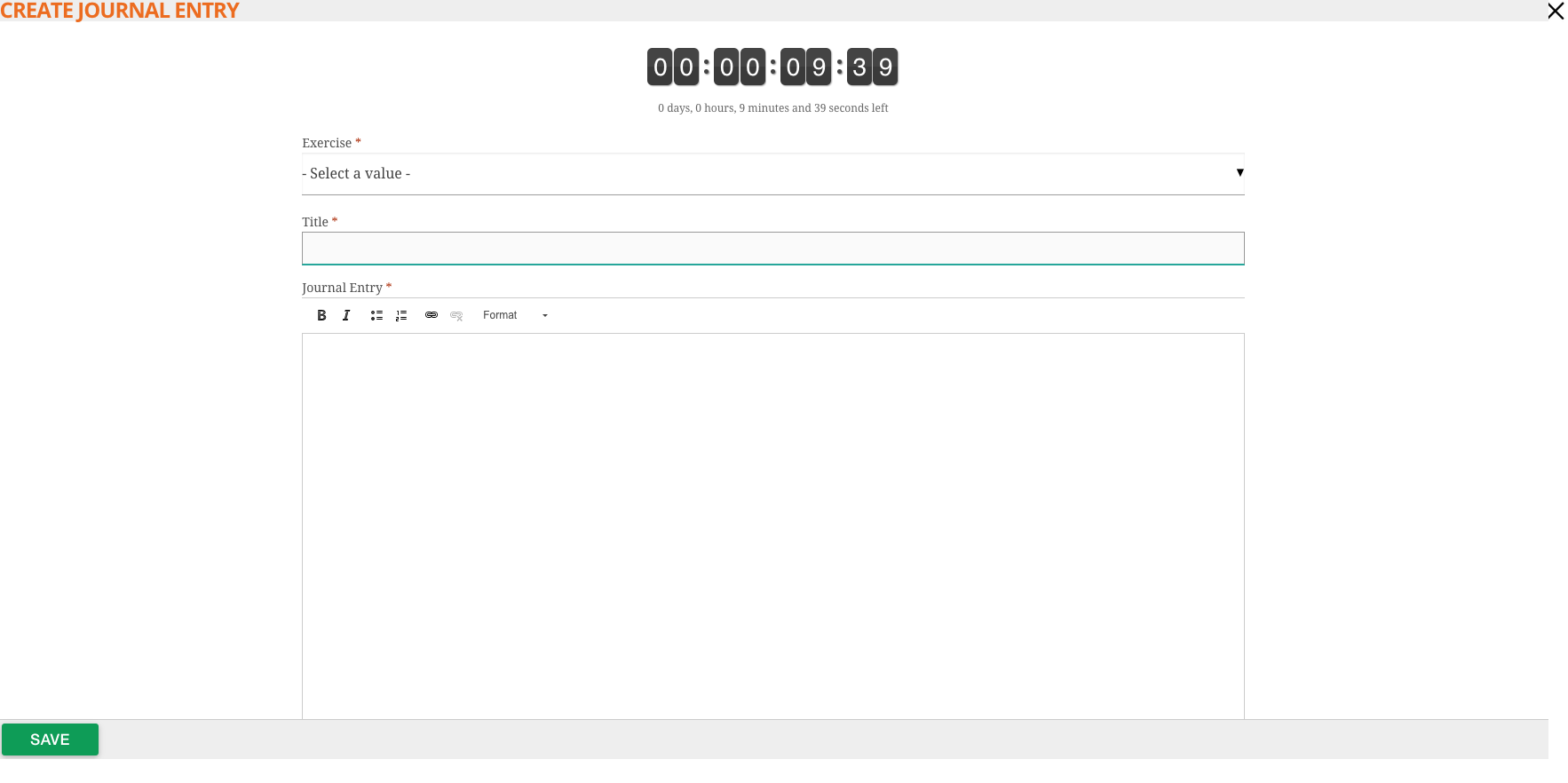
In-class critique process generally followed this pattern: (1) one student initiated the critique (called critter); (2) all students were invited to participate in the discussion. This involved a discussion between the students and their peers that focused on specific aspects of the artifacts that they had submitted. Student work and feedback in the form of ‘critiques’ were made available to the entire class via the class-level studio function of the platform (as seen in Figure 4, below).
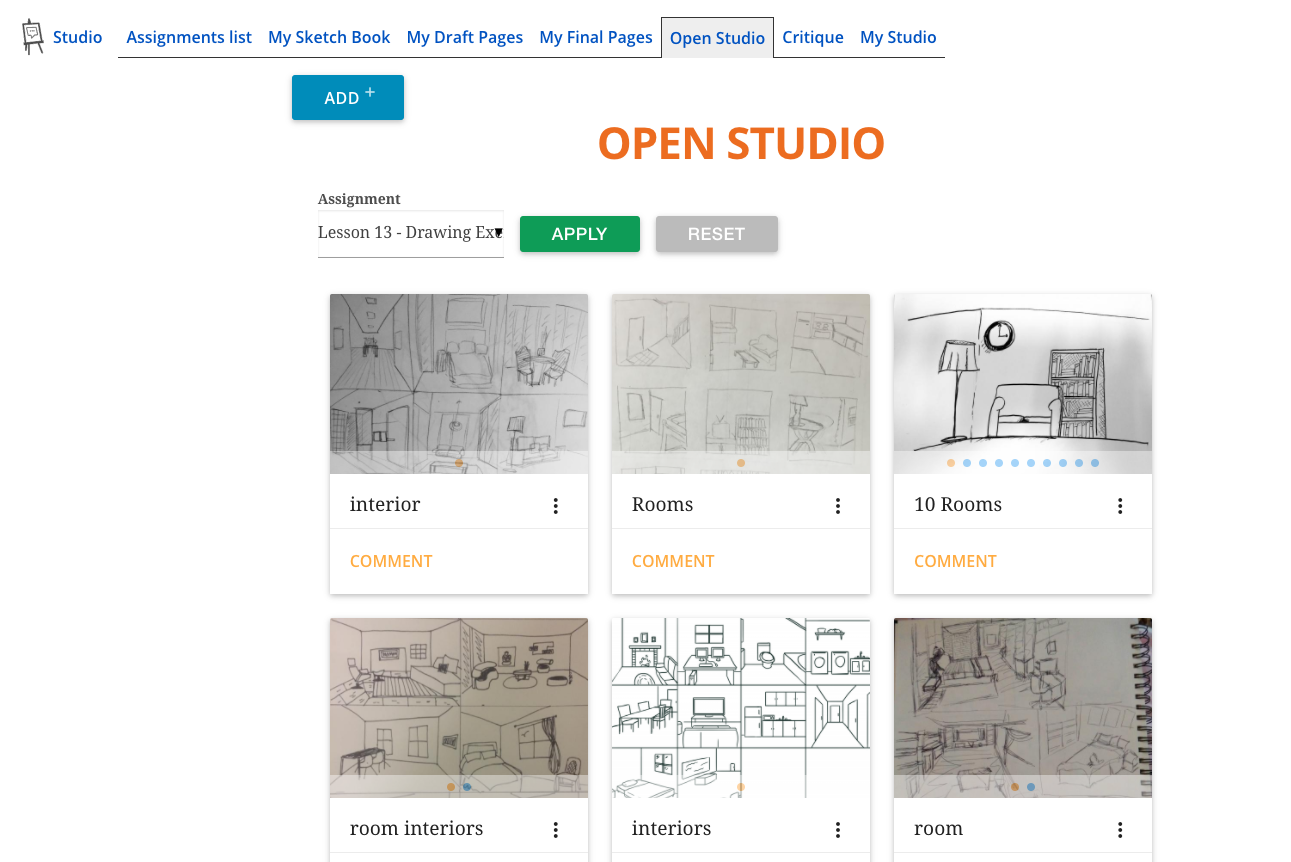
The platform allows students to publish work not only to the instructor, but also to the entire class. The virtual studio permits a variety of file formats and is explicitly designed to accommodate visual submissions. Submitted works can also be selected and enlarged for closer viewing within the platform.
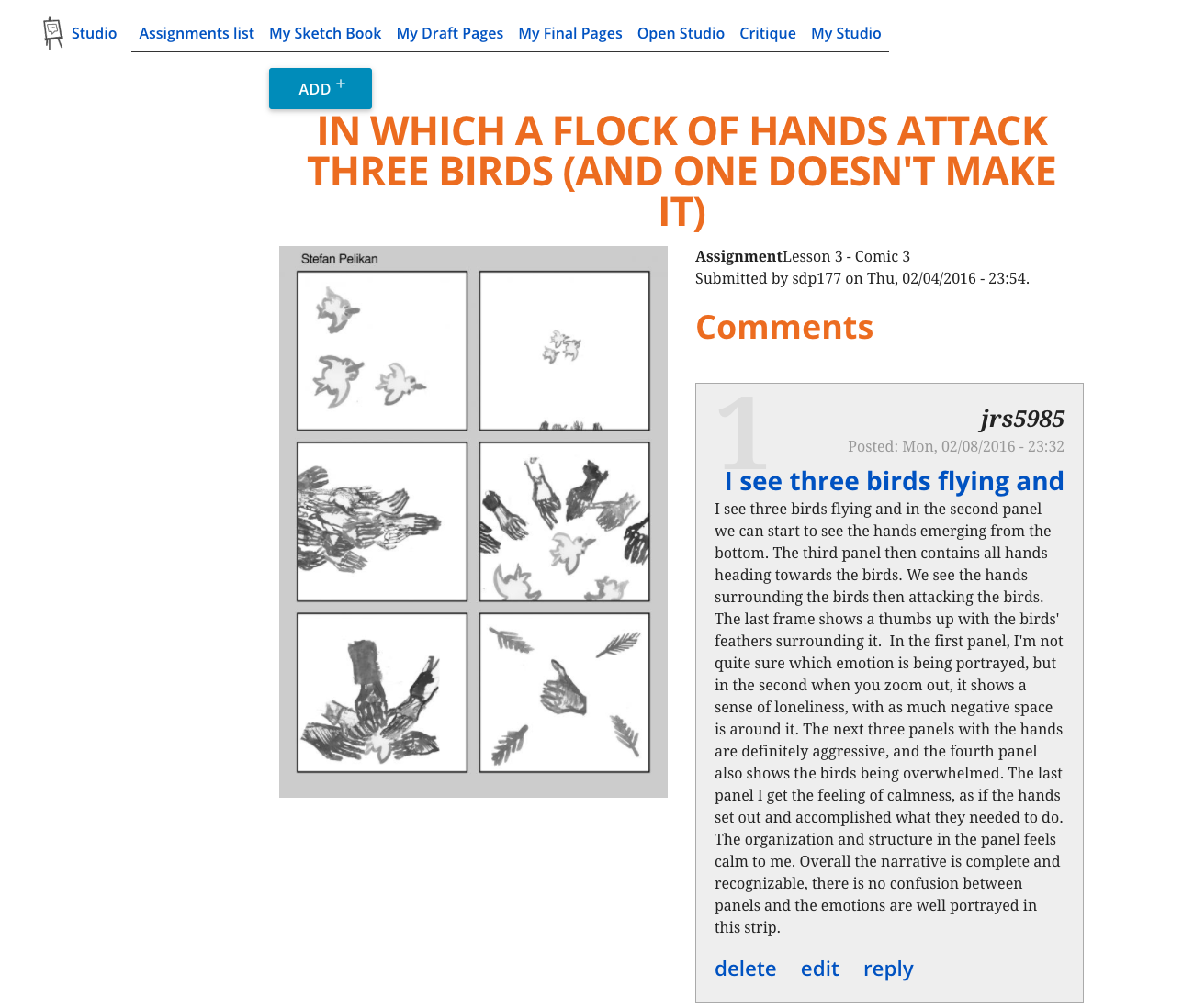
An advantage of these digital critique tools is permanence, as there is an inherently ephemeral nature to critique provided within the resident studio context. Unless the session is recorded or all students individually, capturing all comments related to their submitted work, the invaluable feedback provided by peers might be lost due to the transience and temporally bound nature of the studio experience.
Our attempts to approximate signature pedagogies of the studio environment were and continue to be ongoing and iterative in nature. The platform functions and tools that we have forged and hope to refine may be humble steps in some ways, but they do mark important, concerted efforts to address two important challenges related to the studio’s reliance on artefact-driven and communal learning.
While much work remains, data collected from the course has provided early indications of comparative differences in learner activity between virtual and in-person instructional modality. Specifically, differences have emerged in the quantity of the peer critique feedback provided, as well as how the critique conversations unfold. In addition, there are indications that differences in the level of supportive language may exist. Distinctions in how often students directly discuss the work of peers, as opposed to providing socially-focused comments, point toward a potentially important difference in how learners communicate in person versus how they interact in virtual environments.
The use of an end product as the basis for learning is an idea shared by several researchers in education and the arts. Krajcik and Shin (2014) discuss student creation of tangible objects in the context of project-based learning approaches. The authors describe the importance of objects as external representations of learning. The also explicitly highlight the ‘publicly accessible’ nature of the artefacts. This accessibility, or visibility, to others is a key aspect of studio teaching and a primary characteristic of ‘critiques’.
The artefact, then, holds great importance as both a mechanism for representation of learning (Halverson and Sheridan, 2014) as well as a tool to think with (Roth, 1996). Given the central role of the artefact, a focus on how work is captured, expanded upon and shared continues to inform our design decisions related to digital studio platform tools. The staged and culminating assignments enabled by our platform aspire to recognise the essential role the artefact plays within studio learning.
Since learning takes place largely through interaction, the social context of the studio is a unique and very powerful signature characteristic. Individual learning, via posting questions, pursuing lines of inquiry together, and seeing how others learn, all work together to create a learning environment that enhances group meaning making (Stahl, Koschmann and Suthers, 2014). These processes, based on interactions like sharing and negotiation, develop opportunities for individual learners to grow in their understanding. Ideally, learning environments are designed to foster co-construction of knowledge, meaning and a mutually shared sense making (Miyake and Kirschner, 2014).
Facilitating peer critique, then, remains a primary goal for any platform that aspires to approximate the studio experience. If studio practice is seen as inherently social, then we must continue to refine our platform tools to allow more and better ways for students to share their work with one another. One fruitful possibility for enhancing the critique experience, which was gathered via student focus groups, was the idea of multimedia feedback for peer critique. With adequate digital platform tools, students can then provide video-based critique of their peers’ work. The additional added feature of pen tools to permit drawing on top of submitted work could allow students to make more specific, meaningful comments and suggestions.
While important explorations ‐ related to the approximation of the design studio via digital tools ‐ occurred during the course of this case study, it also revealed that there are challenges to address as significant portions of signature studio characteristics remain difficult to solve. These challenges include how to best approximate the studio’s embodied space, the sense of community that typically evolves amongst studio learners, and the persistent availability of tools and materials.
The traditional design studio is a physical space often resulting from careful planning and design. Farias and Wilkie (2015) describe the studio as intentionally organised within a specific space, one which includes a temporal dimension. Display spaces for works are essential, as are accommodations for small groupings of learners (Hetland et al, 2013). Designers are beginning to recognize the impact space has on how activities unfold within a studio setting, as opposed to a view that sees space as a simple container for action (Farias and Wilkie, 2015). In this relational perspective, space is not something that is ‘already there’, but instead it is dynamically shaped for a particular interaction (Broth, 2009). The community of the studio, comprised of learners and instructors, is a critical aspect of the studio environment, as are the formal and informal interactions between all members of the studio community (Cox, Harrison and Hoadley, 2008). Finally, learners within the studio have constant access to materials and tools through which they can explore and create (Cox, Harrison and Hoadley, 2008).
Continued work in these areas will be critical to the design of learning spaces whether in person or virtual, and that provide essential aspects of studio pedagogy. Despite these significant challenges, digital platforms will continue to change and adjust in attempting to provide meaningful studio practice opportunities for learners and teachers. The value of digital platforms in preparing learners for future work dictates that such iterative efforts persist.
Barab, S.A., Hay, K.E., Barnett, M. and Squire, K. (2001) ‘Constructing virtual worlds: tracing the historical development of learner practices’, Cognition and Instruction, 19(1), pp.47-94. http://dx.doi.org/10.1207/S1532690XCI1901_2.
Broadfoot, O. and Bennett, R. (2003) ‘Design studios: Online? Comparing traditional face-to-face design studio education with modern Internet-based design studios’. Available at: http://citeseerx.ist.psu.edu/viewdoc/download?doi=10.1.1.124.3548&rep=rep1&type=pdf (Accessed: 30 March 2017).
Broth, M. (2009) ‘Seeing through screens, hearing through speakers: managing distant studio space in television control room interaction’, Journal of Pragmatics, 41(10), pp.1998-2016. http://dx.doi.org/10.1016/j.pragma.2008.09.023.
Cennamo, K., Brandt, C., Scott, B., Douglas, S., McGrath, M., Reimer, Y. and Vernon, M. (2011) ‘Managing the complexity of design problems through studio-based learning’, Interdisciplinary Journal of Problem-based Learning, 5(2). https://dx.doi.org/10.7771/1541-5015.1253.
Cox, C., Harrison, S. and Hoadley, C. (2008) ‘Applying the “studio model” to learning technology design’ in Digiano, C., Goldman, S. and Chorost, M. (eds.) Educating learning technology designers: guiding and inspiring creators of innovative educational tools. New York: Routledge, pp.145-164.
Crowther, P. (2013) ‘Understanding the signature pedagogy of the design studio and the opportunities for its technological enhancement’, Journal of Learning Design, 6(3), pp.18-28. http://dx.doi.org/10.5204/jld.v6i3.155.
Damşa, C.I. (2014) ‘The multi-layered nature of small-group learning: productive interactions in object-oriented collaboration’, International Journal of Computer-Supported Collaborative Learning, 9(3), pp.247-281. http://dx.doi.org/10.1007/s11412-014-9193-8.
Farías, I. and Wilkie, A. (eds.) (2015) Studio studies: operations, topologies and displacements. New York: Routledge.
Galford, G., Hawkins, S. and Hertweck, M. (2015) ‘Problem-based learning as a model for the Interior Design classroom: bridging the skills divide between academia and practice’, Interdisciplinary Journal of Problem-Based Learning, 9(2). http://dx.doi.org/10.7771/1541-5015.1527.
Halverson, E.R. (2013) ‘Digital art making as a representational process.’ Journal of the Learning Sciences, 22(1), pp.121-162.
Halverson, E.R. and Sheridan, K. (2014) ‘Arts education and the learning sciences’ in Sawyer, R.K. (ed.) The Cambridge handbook of the learning sciences. 2nd edn. New York: Cambridge University Press, pp.626-648.
Hetland, L., Winner, E., Veenema, S. and Sheridan, K.M. (2013) Studio thinking 2: the real benefits of visual arts education. 2nd edn. New York: Teachers College Press.
Krajcik, J.S. and Shinn, N. (2014) ‘Project-based learning’ in Sawyer, R.K. (ed.) The Cambridge handbook of the learning sciences. 2nd edn. New York: Cambridge University Press, pp.275-297.
Mathews, J. (2010) ‘Using a studio-based pedagogy to engage students in the design of mobile-based media’, English Teaching: Practice & Critique, 9(1), pp.87-102. Available at: https://edlinked.soe.waikato.ac.nz/research/journal/view.php?article=true&id=633&p=1 (Accessed: 30 March 2017).
Miyake, N. and Kirscher, P.A. (2014) ‘The social and interactive dimensions of collaborative learning’ in Sawyer, R.K. (ed.) The Cambridge handbook of the learning sciences. 2nd edn. New York: Cambridge University Press, pp.418-438.
Nathan, M.J. and Sawyer, R.K. (2014) ‘Foundations of learning sciences’ in Sawyer, R.K. (ed.) The Cambridge handbook of the learning sciences. 2nd edn. New York: Cambridge University Press, pp.21-43.
Roth, W.M. (1996) ‘Art and artefact of children's designing: a situated cognition perspective’, Journal of the Learning Sciences, 5(2), pp.129-166. http://dx.doi.org/10.1207/s15327809jls0502_2.
Stahl, G., Koschmann, T. and Suthers, D. (2014) ‘Computer-supported collaborative learning’ in Sawyer, R.K. (ed.) The Cambridge handbook of the learning sciences. 2nd edn. New York: Cambridge University Press, pp.479-500.
Gary Chinn is Assistant Dean for Digital Learning in the College of Arts and Architecture, and a doctoral candidate in the Learning, Design, and Technology program within the College of Education at Pennsylvania State University. Gary previously served as eLearning Initiative Project Manager at the Leonhard Center for the Enhancement of Engineering Education in the College of Engineering.
Jessica Briskin is a doctoral candidate in the Learning, Design, and Technology program within the College of Education at Penn State. In addition, Jessica is faculty at Bloomsburg University and Ithaca College, teaching courses in instructional design and strategic communications.
Dr Susan Land is Associate Professor of Education in the Learning, Design and Technology department within the College of Education at Penn State. Her research emphasizes frameworks for the design of open-ended, technology-enhanced learning environments. She has studied learning with technology in classroom contexts using methods such as project-based learning, computer game design, ill-structured problem solving, and mobile learning. Susan’s current research investigates the design of learning environments afforded by new media in everyday, informal, or classroom contexts and often utilizes technologies such as social media or mobile devices. Her research with the Augmented and Mobile Learning Research Group focuses on context-sensitive, place-based learning in outdoor informal environments using mobile technologies and augmented reality.
Joel Priddy is associate professor within the Graphic Design program in the College of Arts and Architecture. Joel is an award-winning illustrator and cartoonist. His graphic novels include Pulpatoon: Pilgrimage, The Preposterous Voyages of IronHide Tom, and The Gift of the Magi. He has taught design, illustration, and sequential art at Virginia Commonwealth University, Memphis College of Art, and Penn State.